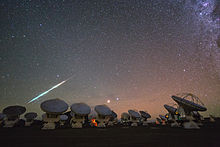What are shooting stars or meteors?« Back to Questions List
|
A shooting star is the visible part of small dust or rocks from space. It burns up as it travels through the atmosphere of the Earth. It may look like a star shooting past the sky and hence is popularly known as a shooting star. They are also known as meteors. A comet, another celestial body, is an icy small Solar System body. When a comet passes close to the Sun, it gets warm and release gases through a process called outgassing. Comets are rare and elusive. . But sometimes, they may remain visible for weeks or even months at a time. Most of the shooting stars are caused by debris left behind when a comet passes by. When the fragments enter the atmosphere, friction causes them to vaporize and produce the streaks of light known as meteors, or shooting stars. Few others are caused by the larger chunks of interplanetary debris that burn as they enter the atmosphere. Meteor and meteoroid are different. Meteor is the flash of light caused by the burning of planetary debris. The debris is called meteoroid. Most meteoroids that enter the atmosphere are so small that they burn and vaporize completely. Meteoroid reaches the surface of the Earth very rarely. If large enough, the meteoroid will survive the burning up in the atmosphere and will fall to sea or land and it is then considered a meteorite. They range in size from few ounces to several tons. Sometimes, meteors flash through the sky one after the other in large numbers. A series of meteors appearing moments or minutes after and appearing to originate from the same fixed point in the sky is called a meteor shower. Some of the meteor showers repeat annually or at regular intervals as the earth passes through the trail of dusty debris left by a comet. Meteor showers are often named after the star or constellation near to the meteors.
Leonids of Tempel-Turtle, Perseids, the Aquarids and Orionids of Halley’s comet and the Taurids of Encke are some of the famous meteor showers. Of these, Perseids, which peaks around August 12 every year, is the most famous. It is a tiny piece of comet Swift Tuttle, which goes past the Sun every 135 years. What are planetoids?What are solar flares and solar prominence? |

